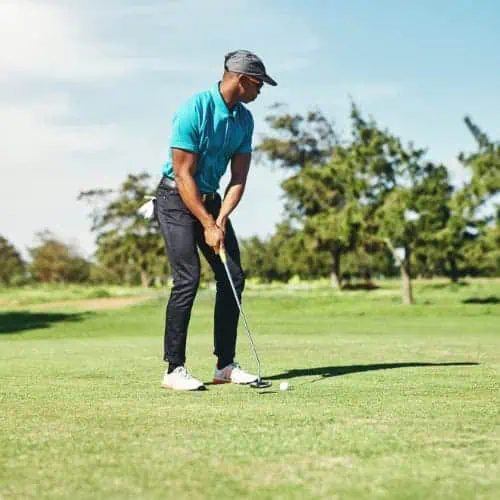Golf is a sport that demands skill and precision as well as a high level of physical fitness. Many golfers overlook the importance of maintaining a well-conditioned body, focusing solely on perfecting their swing technique and mental game. However, neglecting physical fitness can lead to suboptimal performance on the course and an increased risk of injury.
In this article, we will explore some physical exercises you can include in your practice routine to ensure you stay in top shape for your visits to the course. We will also answer some commonly asked questions to cover all the sapects of the topic at hand.
- 1) How Can Proper Training Improve Your Golf Game?
- 2) Key Physical Attributes for Golfers
- 3) Essential Golf Fitness Exercises
- 4) Designing a Golf Fitness Program
- 5) Golf-Specific Training
- 6) Nutrition and Hydration for Golfers
- 7) Injury Prevention and Management
- 8) Mental Preparation and Fitness
- 9) Integrating Fitness into Your Golf Routine
-
10)
Frequently Asked Questions
- 10.1) How often should I train for golf fitness?
- 10.2) What equipment do I need for a golf fitness program?
- 10.3) How long will it take to see improvements in my golf game through fitness training?
- 10.4) Are there any age-specific considerations when starting a golf fitness program?
- 10.5) Should I focus on strength training or flexibility exercises for better golf performance?
- 10.6) Can golf fitness exercises help prevent common injuries like golfer’s elbow or back pain?
- 10.7) How can I maintain my golf fitness routine while traveling for tournaments or vacations?
- 10.8) Are there any specific nutritional supplements that can enhance my golf fitness progress?
- 10.9) How do I know if I’m overtraining or pushing myself too hard in my golf fitness program?
- 11) Final Thoughts
How Can Proper Training Improve Your Golf Game?
To unlock your full potential on the course, you must embrace a comprehensive fitness regimen tailored to your specific needs and goals. A well-designed training program should incorporate exercises that target the key physical attributes essential for optimal golf performance, such as flexibility, core strength, muscular endurance, balance, and coordination.

In order to generate more power in your swing, you should focus on exercises that develop rotational power and speed.
Flexibility and mobility exercises help achieve a fuller range of motion, allowing for a more fluid and powerful swing. Core strengthening exercises, such as planks and rotational movements, provide the stability needed to maintain proper posture and control throughout the swing. Resistance training exercises build muscular endurance, enabling you to maintain consistent swing mechanics and prevent fatigue-related errors.
Incorporating balance and coordination drills into a golf fitness routine can also yield significant benefits. These exercises help you develop a better sense of body awareness and control, translating to improved stability and accuracy on the course. By training the neuromuscular system to work efficiently, you can execute shots with greater precision and confidence.
Key Physical Attributes for Golfers
To achieve optimal performance on the course, you must develop and maintain a set of key physical attributes that directly impact your swing mechanics, power and consistency.
The following are the four essential physical attributes that every golfer should prioritize in their fitness training:
Flexibility and Mobility
Flexibility and mobility are essential for golfers looking to achieve a full range of motion in their swing. Adequate flexibility allows for a smooth, fluid swing that generates maximum power and speed, while poor flexibility can lead to compensatory movements that disrupt swing mechanics and increase the risk of injury.
To improve flexibility and mobility, you should focus on stretching exercises that target key areas such as the shoulders, hips and lower back. Dynamic stretches, which involve moving through a range of motion, are particularly beneficial as they mimic the movements encountered during the swing. Regular stretching routines can help you maintain optimal flexibility, reduce muscle tension and prevent common golf-related injuries.
Core Strength and Stability

The core muscles, which include the abdominals, obliques and lower back, play a vital role in your ability to generate power and maintain stability throughout the swing. A strong, stable core acts as a fulcrum, allowing for efficient energy transfer from the lower body to the upper body and, ultimately, to the clubhead.
Golfers with weak core muscles often struggle to maintain proper posture and alignment, leading to inconsistent ball striking and reduced distance.
To build core strength and stability, you should incorporate exercises such as planks, bridges and rotational movements into your fitness routine. These exercises target the deep, stabilizing muscles of the core, helping you develop the necessary control and endurance to maintain proper form throughout the swing.
A well-conditioned core not only enhances performance but also reduces the risk of lower back pain, a common issue among golfers.
Muscular Endurance
Muscular endurance refers to the ability of the muscles to perform repeated contractions over an extended period without fatigue. For golfers, muscular endurance is crucial for maintaining consistent swing mechanics and power output throughout a round. As fatigue sets in, golfers with poor muscular endurance often experience a breakdown in technique, leading to errant shots and decreased distance.
To improve muscular endurance, you should engage in resistance training exercises that challenge the muscles with moderate weights and higher repetitions. Exercises such as squats, lunges, rows, and push-ups help build the strength and stamina needed to maintain proper form and control throughout the swing.
Additionally, cardiovascular training, such as jogging or cycling, can enhance the overall endurance and help you stay focused and energized during long rounds.
Balance and Coordination

Good balance allows you to maintain proper posture and alignment throughout the swing, ensuring consistent contact with the ball. Coordination, on the other hand, enables you to synchronize the movements of your body parts, creating a smooth, efficient swing sequence.
To enhance balance and coordination, you should incorporate exercises that challenge your proprioception and stability. Single-leg stance exercises, balance board training and medicine ball throws are all effective ways to improve balance and coordination.
Essential Golf Fitness Exercises
Having discussed the key physical attributes you should develop to improve your performance, it’s time to explore a range of essential golf fitness exercises to enhance your physical capabilities.
Warm-Up Routines
A proper warm-up routine is crucial for preparing the body for the demands of the golf swing and reducing the risk of injury. Effective warm-up routines should include a combination of dynamic stretches and mobility drills that target the key muscle groups involved in the swing.
Dynamic Stretches
Dynamic stretches involve moving the body through a range of motion, gradually increasing the intensity and speed of the movements. Examples include:
- Arm circles
- Trunk rotations
- Leg swings
- Walking lunges
These stretches help increase blood flow, elevate body temperature and prime the muscles for the upcoming activity.
Mobility Drills
Mobility drills focus on improving the range of motion in the joints and enhancing the body’s overall flexibility. Some effective mobility drills for golfers include thoracic spine rotations, hip circles, ankle circles, and wrist and forearm rotations.
These drills help ensure that the body can move freely and efficiently throughout the swing.
Flexibility Exercises
Flexibility is a critical component of a golfer’s physical fitness, allowing for a full range of motion in the swing and reducing the risk of injury. Flexibility exercises should target the main muscle groups involved in the golf swing, such as the shoulders, hips and lower back.
Shoulder Stretches

Maintaining adequate flexibility in the shoulder area is essential for generating power and preventing injuries.
Cross-arm, doorway and sleeper stretches are some highly effective shoulder stretches. These help improve shoulder mobility and reduce the risk of common golf-related injuries, such as rotator cuff strains.
Hip Flexor Stretches
Tight hip flexors can limit the range of motion in the hips, leading to a loss of power and consistency in the swing. You can include some effective hip flexor stretches, which help improve hip mobility and allow for a more fluid, powerful swing. Great examples include the following:
- Kneeling hip flexor stretches
- Pigeon stretches
- Standing hip flexor stretches
Lower Back Stretches
The lower back is subject to significant stress during the swing, and maintaining flexibility in this area is crucial for preventing injuries and ensuring optimal performance.
Some effective lower back stretches include cat-cow stretches, seated spinal twists, knee-to-chest stretches, etc. They help alleviate tension in the lower back, improve spinal mobility and reduce the risk of golf-related back pain.
Core Strengthening Exercises
A strong, stable core is the foundation of a powerful and consistent swing. Core strengthening exercises should target the deep stabilizing muscles of the abdominals, obliques and lower back. Effective core strengthening exercises for golfers include:
- Planks (and variations) are a classic core exercise that engages multiple muscle groups simultaneously. Variations of the plank, such as side planks and stability ball planks, can further challenge the core and improve overall stability.
- Russian twists are an excellent exercise for targeting the obliques and improving rotational strength, a key swing component. This exercise can be performed with body weight or with the addition of a medicine ball or weight plate for added resistance.
- Medicine ball rotations are another effective exercise for developing rotational power and core stability. This exercise involves rotating the torso while holding a medicine ball, mimicking the motion of the golf swing.
Resistance Training Exercises
Resistance training is essential for building strength, power and muscular endurance, all of which are critical for optimal golf performance. Resistance training exercises should focus on compound movements that engage multiple muscle groups simultaneously.

Squats and lunges target the lower body muscles, including the quadriceps, hamstrings and glutes. These exercises help generate power from the ground up, improving driving distance and overall swing mechanics.
In addition, rows and pull-downs target the upper back and shoulder muscles, which are essential for maintaining posture and stability. These help prevent upper body fatigue and improve overall strength and control.
Also, push-ups and bench presses target the chest, shoulders and triceps, helping to build upper body strength and stability. These exercises are particularly beneficial for golfers looking to improve their swing speed and power.
Balance and Coordination Drills
Balance and coordination are critical for maintaining proper form and control. Balance and coordination drills help develop body awareness and improve your ability to execute precise, consistent shots. Here are a few drills to consider:
- Single-leg stance exercises challenge balance and stability by requiring you to maintain proper posture while standing on one leg. These exercises can be progressed by adding movement or external perturbations, such as swinging a club or catching a ball.
- Balance board exercises are an effective way to improve overall balance and proprioception. These exercises involve standing on an unstable surface, such as a wobble board or BOSU ball, and performing various movements or swings.
- Medicine ball throws help develop coordination, power and accuracy. These exercises involve throwing a medicine ball in various directions and angles, simulating the motion and force production required in the golf swing.
Designing a Golf Fitness Program
A well-structured golf fitness program is crucial for achieving optimal results and minimizing injury risk. It should be tailored to your individual needs, considering your current fitness level, golf-specific goals, and pre-existing health conditions.
Assessing Your Current Fitness Level

Before starting a golf fitness program, assess your current fitness level to establish a baseline for measuring progress and setting appropriate goals.
A comprehensive fitness assessment should include evaluations of cardiovascular endurance, muscular strength and endurance, flexibility and mobility, balance and coordination, and body composition.
Working with a qualified fitness professional can help you accurately assess your current fitness level and identify areas for improvement.
Setting Realistic Goals
Set realistic, achievable goals for your golf fitness program using the SMART criteria: specific, measurable, attainable, relevant, and time-bound.
Examples of golf fitness goals may include increasing clubhead speed, improving hip mobility for a full shoulder turn or developing core strength to maintain a stable spine angle throughout the swing.
Incorporating Variety in Your Workouts
Incorporate variety in your golf fitness workouts to prevent boredom, avoid plateaus and reduce overuse injury risk. A well-rounded program should include a mix of cardiovascular exercises, resistance training, flexibility and mobility work, balance and coordination drills, and golf-specific exercises.
Varying your workouts ensures that you target all the key physical attributes necessary for optimal golf performance.
Progressive Overload and Periodization
Apply progressive overload by gradually increasing the stress placed upon the body during exercise training. This can be achieved by increasing resistance, performing more repetitions or sets, reducing rest periods, or increasing the frequency or duration of cardiovascular exercise.
Implement periodization by dividing the overall training program into specific phases, each with a particular focus and goal. A periodized golf fitness program may include off-season, pre-season, in-season, and post-season phases, each emphasizing different aspects of fitness development and maintenance.
Rest and Recovery

Prioritize rest and recovery to allow your body to adapt to exercise stresses, repair damaged tissues and replenish energy stores. Ensure sufficient sleep, maintain proper nutrition and hydration, incorporate active recovery techniques, schedule regular rest days or de-load weeks, and listen to your body, adjusting your training as needed.
Golf-Specific Training
Incorporating golf-specific training into your routine helps you translate physical gains to improved performance on the course. Golf-specific training focuses on exercises and drills that closely mimic the movements and demands of the golf swing, helping you develop the specific strength, power and coordination required for optimal ball striking.
Swing-Specific Exercises
Swing-specific exercises target the muscles and movement patterns involved in the golf swing, helping you develop greater power, control and efficiency in your golf game.
- Cable rotations develop rotational strength and power in the core and upper body. Attach a handle to a cable machine at chest height. Stand sideways to the machine, holding the handle with both hands in front of your chest. Rotate your torso away from the machine, keeping your arms straight and core engaged. Slowly return to the starting position and repeat.
- Medicine ball slams develop explosive power and coordination. Stand with your feet shoulder-width apart, holding a medicine ball with both hands in front of your chest. Raise the ball overhead, extending your arms fully. Forcefully slam the ball to the ground in front of you, hinging at the hips and engaging your core. Catch the ball on the rebound and immediately raise it back overhead for the next repetition.
- Resistance band swings improve swing mechanics and increase power output. Attach a resistance band to a stable anchor point at ground level. Stand facing away from the anchor point, holding the other end of the band with both hands. Assume your golf stance, with the band positioned just below your lead hip. Perform a golf swing motion against the resistance of the band, focusing on proper technique and power transfer.
Many golfers struggle with the urge to swing too hard, sacrificing control for power. This can lead to inconsistency and inaccuracy. If you’re looking to improve your swing control and find a more balanced approach, check out our guide on how to prevent swinging too hard in golf.
Putting and Chipping Drills

Incorporating putting and chipping drills into your routine can help improve your touch, accuracy and confidence around the greens. Try the following drills for optimal results:
- Clock Drill: Place balls around a hole at various distances and putt from each position, focusing on speed and accuracy.
- Path Drill: Place alignment sticks on the green to create a narrow path to the hole, encouraging a straight putting stroke.
- Ladder Drill: Set up a series of tees at progressively longer distances from a target, practicing chipping to each tee with the goal of landing the ball as close to the target as possible.
Cardiovascular Training for Endurance on the Course
Cardiovascular endurance plays a crucial role in maintaining focus, energy levels and performance throughout a round. Engage in regular cardiovascular exercise, such as jogging, cycling or swimming, aiming for at least 150 minutes of moderate-intensity aerobic activity or 75 minutes of vigorous-intensity aerobic activity per week.
Also, improve your golf-specific endurance by walking the course, carrying your clubs or using a push cart, playing practice rounds with minimal breaks between shots, and incorporating high-intensity interval training (HIIT) into your workouts.
Nutrition and Hydration for Golfers
Proper nutrition and hydration are essential for optimal golf performance. Consuming a variety of micronutrients, such as vitamins and minerals, is also crucial for supporting bodily functions.
Pre-round meals should be consumed 2-3 hours before tee time and include a balance of complex carbohydrates, lean protein, and healthy fats. For early tee times, opt for lighter meals or snacks.
Post-round nutrition should focus on replenishing energy stores and supporting muscle recovery. Consume a mixture of carbohydrates and protein within 30 minutes of finishing your round, followed by a balanced meal within 2 hours.
Maintaining proper hydration is also essential for golf performance. Drink 16-20 ounces of water or a sports drink 2-3 hours before your tee time and 6-12 ounces of fluid every 15-20 minutes during your round. Choose water or low-sugar sports drinks to replace electrolytes lost through sweat. Monitor your urine color to assess hydration levels.
Injury Prevention and Management

Common golf injuries include golfer’s elbow (medial epicondylitis), lower back pain, rotator cuff injuries, wrist and hand injuries, and knee pain. These injuries often result from overuse, improper technique, lack of flexibility, and poor posture or weak core muscles.
Incorporating proper warm-up and cool-down routines can significantly reduce the risk of injury. A well-designed warm-up should include light cardiovascular activity, dynamic stretches and golf-specific movements. The cool-down routine should consist of light cardiovascular activity, static stretches and foam rolling or self-massage.
Addressing muscle imbalances is essential for preventing injuries and improving performance. Common imbalances include overdeveloped chest muscles compared to back muscles, weak core and gluteal muscles, tight hip flexors and hamstrings, and imbalances between the lead and trail sides of the body. Targeted strength training exercises and stretches can help correct these imbalances.
Seek professional help when experiencing persistent or severe discomfort, such as pain lasting more than a few days, swelling, bruising, reduced range of motion, weakness, radiating pain, or numbness and tingling. Promptly addressing injuries and seeking appropriate treatment can prevent further damage and promote faster recovery.
Mental Preparation and Fitness
Incorporating mental preparation and fitness techniques into your golf training can help you develop the mental resilience and clarity needed to perform at your best on the course.
Visualization, or mental imagery, is a powerful tool for enhancing golf performance. By mentally rehearsing shots, you can reinforce proper technique, build confidence and prepare for various course scenarios. To practice visualization, find a quiet space, close your eyes and imagine yourself on the course, setting up for a specific shot.
Engage your senses and repeat the visualization several times, focusing on a positive outcome.
Furthermore, breathing exercises promote focus, relaxation and stress management. Diaphragmatic breathing involves inhaling deeply through the nose, allowing the belly to expand, and exhaling slowly through the mouth. Box breathing consists of inhaling, holding, exhaling, and holding each for a count of four.
Incorporating these exercises into your pre-shot routine or during high-pressure moments can help maintain focus and manage anxiety.
Integrating Fitness into Your Golf Routine

To make fitness a priority and incorporate a comprehensive golf fitness program into your regular routine, schedule your workouts as non-negotiable appointments, and choose a consistent time each day or week to exercise. Make the most of your time by focusing on high-intensity, compound exercises that target multiple muscle groups simultaneously. Be flexible and adaptable, adjusting your workout schedule or duration as needed.
Maintaining motivation and accountability is key to long-term success. Set clear, achievable goals and break them into smaller milestones. Find a training partner or coach to provide support and encouragement, or join a golf fitness community. Reward yourself for progress, celebrating both big and small achievements.
Regularly tracking your progress helps maintain motivation, identify areas for improvement, and ensure the effectiveness of your program. Keep a fitness journal to record workouts, note challenges and successes, and reflect on improvements. Utilize technology, such as fitness tracking apps or golf-specific tools, to monitor progress objectively. Assess your golf performance by tracking scores, key performance indicators and soliciting feedback from others.
Frequently Asked Questions
The following are answers to some frequently asked questions. We included them to provide as much information as you need for the topic at hand.
How often should I train for golf fitness?
Train 2-3 times per week, focusing on flexibility, strength and cardiovascular exercises. Be consistent and gradually increase the frequency or intensity as your fitness improves.
What equipment do I need for a golf fitness program?
Essential equipment includes resistance bands, dumbbells, a stability ball, a foam roller, and a golf club or weighted club. Additional beneficial equipment includes cable machines, medicine balls and balance boards.
How long will it take to see improvements in my golf game through fitness training?
Timeline varies based on your starting fitness level, consistency, intensity, and individual response. Expect to notice improvements in flexibility, strength and endurance within 4-6 weeks of consistent training.
More significant golf-specific gains occur over several months.
Are there any age-specific considerations when starting a golf fitness program?
Golfers of all ages can benefit from golf fitness programs; still, you should consider individual needs and limitations. Older golfers should focus on flexibility, balance and low-impact exercises to reduce injury risk.
If in doubt, consult a qualified golf fitness professional to ensure an age-appropriate program.
Should I focus on strength training or flexibility exercises for better golf performance?
Both are important. Strength training develops power, stability and endurance for a consistent swing. Flexibility exercises promote a greater range of motion and reduce injury risk. You should incorporate a balanced mix of both types of exercises for the best results.
Can golf fitness exercises help prevent common injuries like golfer’s elbow or back pain?
Yes, a well-designed program addresses muscle imbalances, improves flexibility and strengthens key muscle groups.
Exercises targeting forearms, wrists, shoulders, core, and back help reduce the risk of golfer’s elbow or chronic back pain.
Also, proper warm-up, cool-down, stretching, and mobility work are essential for injury prevention.
How can I maintain my golf fitness routine while traveling for tournaments or vacations?
When traveling, you can research fitness facilities or equipment available at your destination beforehand, pack portable equipment like resistance bands or a jump rope for hotel room workouts and develop a travel-friendly workout plan focusing on bodyweight exercises, stretching and cardiovascular activities.
Are there any specific nutritional supplements that can enhance my golf fitness progress?
A well-balanced diet should be the foundation of your nutritional approach. Protein powders, creatine and omega-3 fatty acids are well-researched supplements for supporting muscle recovery, strength gains and overall health. To be on the safe side, consult a healthcare professional before starting any new supplement regimen.
How do I know if I’m overtraining or pushing myself too hard in my golf fitness program?
Signs of overtraining include persistent fatigue, decreased performance, increased muscle soreness, difficulty sleeping, mood changes, and a higher risk of injury.
Listen to your body and be aware of unusual or persistent symptoms. Incorporate adequate rest and recovery time, and adjust workouts if needed.
If symptoms persist, consult a fitness professional or healthcare provider for guidance.
Final Thoughts
Golf fitness is essential for improving your game, preventing injuries and enhancing overall well-being. By developing key physical attributes, designing a personalized training program and incorporating golf-specific exercises, you can unlock your full potential on the course.
Also, proper nutrition, hydration and injury prevention strategies support your fitness journey, while mental preparation techniques help you excel under pressure. Integrating fitness into your golf routine also requires effective time management, motivation and progress tracking.
If you have any questions or comments, feel free to contact us.
Happy golfing!





